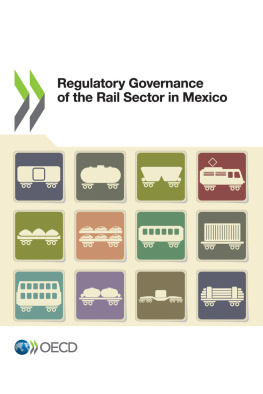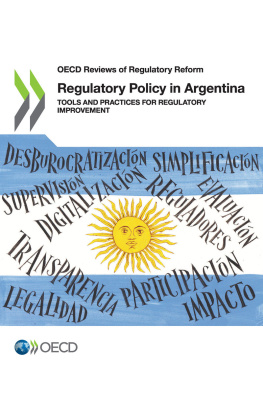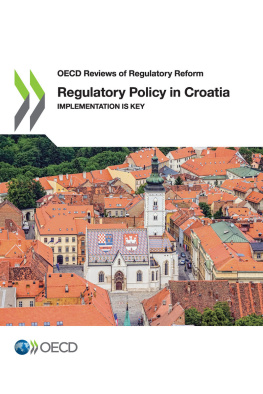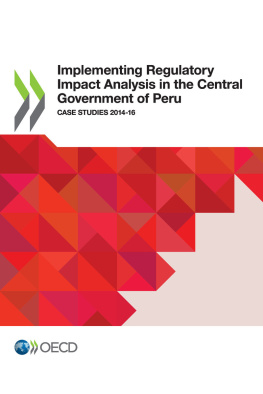OECD - Regulatory Impact Assessment
Here you can read online OECD - Regulatory Impact Assessment full text of the book (entire story) in english for free. Download pdf and epub, get meaning, cover and reviews about this ebook. year: 2020, publisher: OECD Publishing, genre: Politics. Description of the work, (preface) as well as reviews are available. Best literature library LitArk.com created for fans of good reading and offers a wide selection of genres:
Romance novel
Science fiction
Adventure
Detective
Science
History
Home and family
Prose
Art
Politics
Computer
Non-fiction
Religion
Business
Children
Humor
Choose a favorite category and find really read worthwhile books. Enjoy immersion in the world of imagination, feel the emotions of the characters or learn something new for yourself, make an fascinating discovery.
Regulatory Impact Assessment: summary, description and annotation
We offer to read an annotation, description, summary or preface (depends on what the author of the book "Regulatory Impact Assessment" wrote himself). If you haven't found the necessary information about the book — write in the comments, we will try to find it.
OECD: author's other books
Who wrote Regulatory Impact Assessment? Find out the surname, the name of the author of the book and a list of all author's works by series.
Regulatory Impact Assessment — read online for free the complete book (whole text) full work
Below is the text of the book, divided by pages. System saving the place of the last page read, allows you to conveniently read the book "Regulatory Impact Assessment" online for free, without having to search again every time where you left off. Put a bookmark, and you can go to the page where you finished reading at any time.
Font size:
Interval:
Bookmark:

OECD (2020), Regulatory Impact Assessment , OECD Best Practice Principles for Regulatory Policy, OECD Publishing, Paris, https://doi.org/10.1787/7a9638cb-en .
The information in this document with reference to Cyprus relates to the southern part of the Island. There is no single authority representing both Turkish and Greek Cypriot people on the Island. Turkey recognises the Turkish Republic of Northern Cyprus (TRNC). Until a lasting and equitable solution is found within the context of the United Nations, Turkey shall preserve its position concerning the Cyprus issue.
The Republic of Cyprus is recognised by all members of the United Nations with the exception of Turkey. The information in this document relates to the area under the effective control of the Government of the Republic of Cyprus.
This report is part of a series of best practice principles produced under the auspices of the OECD Regulatory Policy Committee.
Regulations are indispensable for the proper functioning of economies and societies. They create the rules of the game for citizens, business, government and civil society. They underpin markets, protect the rights and safety of citizens and ensure the delivery of public goods and services. The objective of regulatory policy is to ensure that the regulatory lever works effectively, so that regulations and regulatory frameworks work in the public interest.
The quality of the regulatory environment and the delivery of regulatory outcomes is strongly dependent on the quality of processes for designing regulations. If used systematically and across the whole of government, regulatory impact assessment (RIA) can ensure better-quality government intervention. In addition, documenting and publishing the evidence and analysis used to design interventions can enhance accountability and transparency in the policy-making and decision-making processes.
The OECD has played a leading international role in promoting regulatory reform and sound regulatory practices across the whole of government. The 2012 OECD Recommendation of the Council on Regulatory Policy and Governance summarises the information and experience it has gathered.
Building on this wealth of information and practices, these Principles provide a synthetic tool to help decision makers, policy makers, civil servants and other practitioners in the public sector internationally better design and implement their RIA systems and strategies.
This document was approved by the Regulatory Policy Committee at its 21st Session on 6 November 2019 and prepared for publication by the OECD Secretariat.
These principles were prepared by the OECD Public Governance Directorate (GOV), under the leadership of Marcos Bonturi, Director. They were drafted by Daniel Trnka, OECD Senior Policy Analyst, under the supervision of Nick Malyshev, Head of the Regulatory Policy Division, GOV. Jennifer Stein co-ordinated the editorial process.
Thanks are extended to all members of the Regulatory Policy Committee who provided substantial comments and support to the various drafts of the principles paper. Extensive and useful comments were provided in the public consultation by Mr. Jonathan Ayto, New Zealand Treasury; Mr. Paolo Paruolo, Joint Research Centre, European Commission; Ms Fabiola Perales, expert on regulatory policy, Mexico and Mr. Yoav Teitelbaum, National Cyber Directorate, Israel.
Regulation is an important tool for achieving governments social, economic and environmental policy objectives. Governments have a broad range of regulatory instruments reflecting the complex and diverse needs of their citizens, communities and economy.
The quality of both the regulatory environment and regulatory outcomes is strongly dependent on the quality of processes for designing regulations. When developing interventions, whether policies, laws, regulations or other types of rule, governments do not always fully consider their likely effects. In addition, government intervention has costs, which might, in some cases, outweigh the anticipated benefits. As a result, there are many instances of unintended consequences and, ultimately, negative impacts for citizens, businesses and society as a whole that essentially result from badly designed interventions. Often, these negative impacts are felt more by smaller, unorganised, hard-to-reach, less informed or marginalised constituents in society. They are thus detrimental to achieving inclusive growth, sustainable development, building trust and maintaining the integrity of the rule of law.
Regulatory impact assessment provides decision makers with crucial information on whether and how to regulate to achieve public policy goals. RIA also helps policy makers defend decisions not to intervene in markets where the costs of doing so outweigh the benefits. RIA further helps defend policy makers decisions by demonstrating that there are benefits to regulation something that is often overlooked by society and governments.
The Principles provide policy makers, civil servants and other public sector practitioners with a practical instrument for better designing and implementing RIA systems and strategies. The Principles cover a wide range of institutional organisations, tools and practices and present a list of critical steps, as well as dos and donts for developing RIA frameworks.
As a minimum, every process of regulatory impact assessment should include these elements: problem definition, objective, description of the regulatory proposal, identification of alternatives, analysis of benefit and costs, identification of the preferred solution and setting out the monitoring and evaluation framework.
For RIA to be successful, it needs to:
Always start at the inception phase of the regulation-making process;
Clearly identify the problem and desired goals of the proposal;
Identify and evaluate all potential alternative solutions (including non-regulatory ones);
Font size:
Interval:
Bookmark:
Similar books «Regulatory Impact Assessment»
Look at similar books to Regulatory Impact Assessment. We have selected literature similar in name and meaning in the hope of providing readers with more options to find new, interesting, not yet read works.
Discussion, reviews of the book Regulatory Impact Assessment and just readers' own opinions. Leave your comments, write what you think about the work, its meaning or the main characters. Specify what exactly you liked and what you didn't like, and why you think so.



















